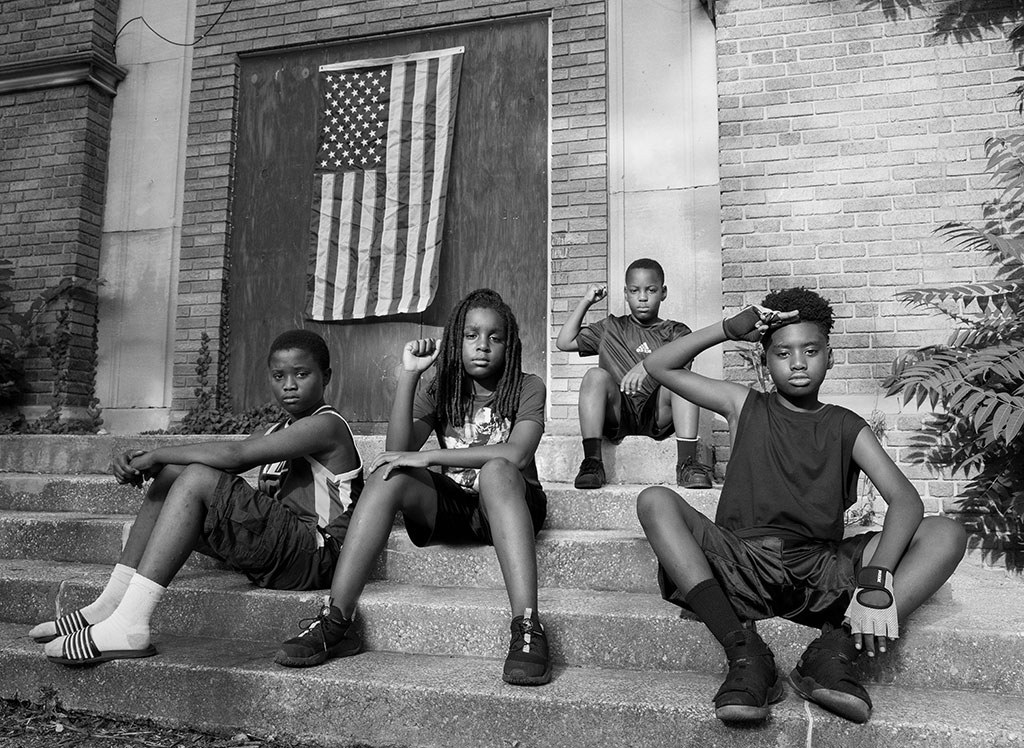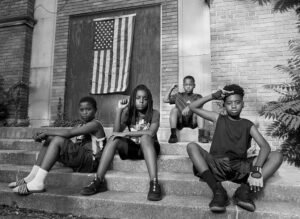
Amanda D. King is a creative strategist, artist, and activist pursuing justice and equity and envisioning possibilities for social transformation through arts and culture. Amanda serves as Creative Director and co-founder of Shooting Without Bullets – a nonprofit creative and social enterprise using cultural production and creative strategies to advance social movement for Black and Brown youth, artists, and communities.
I spoke with Amanda over Zoom in April, about her work, ideas and aims. This is part one of our conversation. The full

transcript will be published shortly online, here at www.newartexaminer.net
DJ: You’ve talked of the profound impact that seeing images of lynching at the Andy Warhol Museum in 2001 had on you. In 2020 you questioned the Museum of Contemporary Art Cleveland’s motivations concerning police violence and appropriation of Black bodies in art. During the twenty years between those events how has the conversation about artistic representation of trauma evolved, or indeed, has the conversation evolved?
ADK: I’m very aware of the harm that results in showing grotesque violence against Black and Brown folks in this country. I witness it daily through popular culture and social media. Society is so inundated with these images that they become a normalized part of daily life, and they shouldn’t be. This morning when I woke up and opened the NPR app, the first image on the landing page was of an officer pepper-spraying a Black lieutenant. As a Black person that is how I start my day. You can too easily find images of Black people being brutalized by the state, and by other people. This violence is so accessible and frequently engaged with that its gravity weighs heavily on our cultural experience and our self-esteem; on young peoples’ perceptions of life in this country, and how they navigate and move through it. I’ve witnessed it create an immense sense of fear and trepidation in our movement, because of the constant reminders that this could happen to me.
I’ve seen films like Queen and Slim that have tried to address police brutality but made it entertainment. Sometimes these representations are counter-productive to our movement if we engage with them at face value. While they might raise awareness, they fail to be truly activist in the fact that they’re not advocating for the abolition of a system. Likewise, when the media publishes images of Black death and suffering but doesn’t use those images to push conversation towards abolition then it’s not serving the movement, it’s not serving the people, it’s not continuing the fight for anything achievable, it’s just taking up space.
But I’ve also seen the beauty of what Harvard professor, Sarah Elizabeth Lewis, termed “representational justice.” Using art as this corrective tool or alternative form of justice to affirm the dignity and humanity of Black people. I see this specifically in my medium, photography. For every image of brutality there are equally persuasive images of Black beauty and Black resilience. I am a part of a school of Black social thought that is committed to image-making for liberation. I do not believe in just replicating and duplicating pictures of Black trauma, death, and suffering, especially if it is not for abolition. That’s my perspective and I do push back against other artists who are not being so intentional. I’m not alone. I see people in the art world holding artists and institutions accountable for exhibiting images that are not affirming or that harm our movement. The power of our voices, especially in arts and culture, have profound influence over what happens in these other spaces.

Regarding the impact of seeing lynching images as a youth; when I witnessed them, I was walking through a gallery with my parents. I knew that there was something very grave happening, when they straightened up in alignment with the work, in reverence, not to the violence; to the victim, to the Black body. They were demonstrating solidarity. This memory shapes my visual, ethic and moral responsibility as an artist.
My parents brought profound context to the work that allowed for deeper understanding. My mother is of the first generations to desegregate schools in Alabama. My grandmother was a sharecropper. Lynching is not an abstract concept to them. It was a part of Alabama culture. My father was a civil attorney, and he worked with traumatic images of accidents and death, as well as images of police brutality. He also witnessed the heinous murders of Black leaders in the 1960s and 70s. He brought that context with him. They could engage with these traumatic images on a different level because they directly correlated to their lived experience. But there were other people in the gallery who needed to consume those images to gain context for their own lived experience; to see their privilege and develop empathy for someone’s experience that wasn’t like theirs. This is a dangerous approach to consuming art—to look for validation or deeper understanding of your own life by witnessing the trauma of another. Black people can handle images of police brutality and engage in critical conversation around them because state violence is part of our everyday existence. But someone who does not have our skin color, or who does not have the power dynamics between citizen and police at play in their lives cannot deeply interrogate images of state-sanctioned violence without education, and that cannot be acquired in a single gallery visit.
It’s very dangerous for the artist to put that trauma out there and expect for people to take meaning away from it. I believe that if you show these images there must be intentionality, and there must be a critical framework from which you are working and from which you are educating, not from a place of empathy but from a place of abolition.
DJ: To think of the endless stream of media and images that are superficially addressing many of these issues, but actually deepening the wounds, I think of the opportunity we have in our work to push against that impulse, with the same tools of digital dissemination. I’m reminded of that moment last year, when the hashtag for the Proud Boys was commandeered by gay people, and the internet was flooded with images of love as a counter-narrative for that term, for a community that I belong to. It was a moment of positive imagery and engagement, but there was also a dash of humor in the wordplay that reoriented something hateful into something beautiful.
ADK: I don’t grapple with images of trauma outside of an activist context. It must be for the advocacy, dismantling, or the refusal of oppressive systems. Humor and joy are so innate in the Black experience, and in the experience of all oppressed people. It’s important for us to also create and engage with artworks, or memes, or music about the Black quotidian or Black joy, absent references to white supremacy or suffering. There is so much injustice in the arts and society that forces Black artists to be corrective. It’s a disservice to us when we are obligated to push and propel society so far through our artwork and our practices that it becomes challenging to express the fullness of who we are outside of rage and pain. This is the burden of Black artists in this moment.
DJ: Yes, part of creativity and art-making is play, and pleasure, experiment and failure. And what you’re describing doesn’t allow for failure. Even that dynamic is set up by a system that needs to be annulled and rebuilt. It becomes then another insidious layer of oppression even within the creative act.
ADK: Permission to play and experiment is something that I struggle with daily, and it’s why I created a mechanism and platform like Shooting Without Bullets. I want to teach young people that they can make activist art, and still have the freedom to play and experiment. There’s not a lot of room for experimentation within Cleveland’s homogenous art market, but what I’ve learned from being in this art system are tools that allow me to cultivate a community where young Black and Brown artists are supported with the resources, with the time, with development, guidance, and partnership. Making space for young Black artists to hone their artistic talents while furthering social movement is profound and revolutionary.

DJ: The sensitivity and reverence that you apply toward encouraging responsible stewardship in portrayals of slain Black people makes dignity and humanity central aspects of cultural remembrance. What are your greatest concerns—what is lost— when those elements aren’t considered in visual modes of expression.
ADK: What is lost is everyone’s humanity. From the person who witnesses it, to the subject that it’s about, to the artist who makes it, no one’s humanity is present in that moment. If you cannot honor someone who deserves dignity and representation, especially in their death, then making the work does nothing for the dead, but it also does nothing for the living. To show a Black corpse is not to invoke empathy, it is to show an empty container, an empty body that has been defeated by racism, that’s all it becomes.
And so then what are we looking at? Racism. Racism isn’t a new notion. We’re experiencing and navigating it every day; we see racism in art galleries, on the street, and on our smartphones. Racism isn’t a novelty. So, what might our encounters with Black death look like if we visited EJ Hill’s University of Saint Tamir? What would it be like imagining an education system that reveres Black boys? That is novel. Theaster Gates serving as a steward over the gazebo where Tamir was murdered and transforming it into a place of deep contemplation and respect for him. That’s novel. To honor families directly impacted by state-sanctioned violence in a manner that truly cares for them and refuses to fetishize the violence they experience is not happening in the art world as much as it should.
I value women and mothers like Ms Rice as leaders of our movement. When I was working with Ms Rice, I saw her persist against incredible grief. She is making society better through her fight, through her advocacy and her activism but I know it takes a toll on her. As artists we can address state-sanctioned violence with many tenets. What does it look like to represent a person’s life outside of their final moments? What does it look like for us to use our talents to support the living, like Ms Rice, who continue to fight for justice for us all? Unless we do the deep work of care, and unless we are intentional about dismantling brutal systems, then we do a disservice to every single being who witnesses this work.
Volume 35 no 5 May/June 2021

